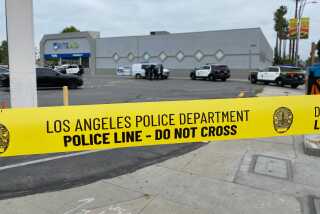Dallas police used a robot to kill a gunman, a new tactic that raises ethical questions
Reporting from Washington — Negotiators had been talking for hours with the hunkered-down killer of five police officers in downtown Dallas when the man suddenly resumed firing with an assault rifle.
Fearing additional casualties, the officers deployed a small, remote-controlled robot to carry an explosive device near shooter Micah Xavier Johnson, 25, which they then detonated, killing him.
“We saw no other option but to use our bomb robot and place a device on its extension for it to detonate where the suspect was,” Police Chief David Brown said at a news conference Friday morning. “Other options would have exposed our officers to grave danger .… We have confirmed that he’s been deceased because of the detonation of the bomb.”
The Dallas Police Department’s unprecedented use of an explosive-laden robot to kill an armed suspect ushers in a new phase in the militarization of U.S. police departments.
The tactic illustrates what police see as the new opportunities for self-defense presented by advancing technologies and the transfer of second-hand military equipment to local police departments.
But it also raises difficult ethical questions about how and when such technologies should be deployed in a civilian setting to allow police to kill a suspect while facing little or no risk.
As police departments acquire more robots that were once seen only in war zones, civilian law enforcement officers are pushing into territory forged by the CIA and the U.S. Air Force to kill terrorists, said Ryan Calo, an assistant law professor at the University of Washington in Seattle and an expert on robotics and the law.
“This is not the beginning of killer robotics, domestically, but it is hard to distinguish this and a drone strike,” Calo said. “The police had exhausted their other options, they thought.”
Like in the military’s lethal drone program, “they are also trying to minimize collateral damage here. They don’t want to risk officers’ safety,” he said.
While the U.S. military has hundreds of lethal flying drones and a menagerie of other unarmed robots, there are no known operational programs involving lethal unmanned ground vehicles.
After the Dallas standoff, Calo said more robots might be used to confront armed suspects.
These robots are not autonomous. They do not make decisions on their own. They are sophisticated remote-control systems.
— Arthur Holland Michel, co-director of the Center for the Study of the Drone
“Any court would absolve these officers and would do so on the basis of the fact that they were authorized to use force,” Calo said. “This was, after all, a creative solution to a very challenging problem. You might see other police asking themselves, ‘Do we have a robot?’”
Jay Stanley, a senior policy analyst for the American Civil Liberties Union, said the use of remotely controlled robots to apply lethal force may be justified — but it raises concerns about what the future might hold.
“Because ground robots may allow deadly force to be applied more safely and easily, they raise the danger that they will be overused,” he said. “When things get easier to do, they tend to be done too much. Remote uses of force raise policy issues that should be carefully considered and addressed by our society as technology advances and should remain confined to extraordinary situations.”
Deadly confrontations with robots like the one in Dallas are increasingly likely thanks to federal programs that have moved billions of dollars’ worth of surplus military equipment into the hands of local police agencies.
The Pentagon set up a program in 1997 that gave unneeded military equipment such as mine-resistant armored vehicles, grenade launchers and bomb-disposal robots to local police for free. It also includes more mundane things like clothing and office supplies, tools and rescue equipment. Since its inception, the program has transferred more than $6 billion worth of property to more than 8,000 law enforcement agencies enrolled in the program.
The program came under scrutiny after police departments in Ferguson, Mo., and elsewhere used heavy-duty military equipment to quell local protests. President Obama ultimately scaled back the federal program in May 2015, but law enforcement agencies can still acquire basic equipment, such as riot gear, guns and armored trucks.
Editorial: Dallas shooting puts U.S. at a crossroads. Will we address race and criminal justice or allow violence to fester? »
Dallas authorities didn’t identify the type of robot used to kill the gunman.
The Police Department was authorized in 2008 to purchase “a hazardous duty robot and accessories” from Northrop Grumman subsidiary Remotec for $207,671, according to a Dallas City Council document. In June 2015, after a police sniper shot and killed a suspect who had opened fire on department headquarters, police fired a shotgun mounted to a robot to try to open the door of a van carrying explosives.
Arthur Holland Michel, co-director of the Center for the Study of the Drone at Bard College in New York, said the lethal use of a robot is likely going to draw a lot of attention from law enforcement.
He said the MARCbot, which is primarily designed for delivering a remote view in life-threatening instances and handling live ordinance, has been jury-rigged by troops in Iraq to attack targets with mines.
At about 19 inches wide and 13 inches tall, the MARCbot is small and relatively inexpensive. Short for Multifunction, Agile, Remote-Controlled Robot, the device is made by Exponent Inc., an engineering and research firm in Menlo Park, Calif.
Holland Michel said police departments have been using robots for years. They were deployed at the World Trade Center after the Sept. 11 attacks. Their popularity increased with the aid of the Pentagon’s surplus program, he said, saying the program has provided police with at least 400 robots nationwide.
As far as ethical problems, Holland Michel said: “These robots are not autonomous. They do not make decisions on their own. They are sophisticated remote-control systems.”
Ed Obayashi, a police officer and attorney who serves as a legal advisor to several law enforcement agencies on force issues, said Dallas police would have considered and dismissed other options — such as snipers firing from a rooftop or helicopter — before arming a robot with an explosive.
While the gambit spared officers from having to make a more traditional assault on Johnson, the trade-off was an element of unpredictability in the size and force of the explosion, its impact on Johnson and the risk of shrapnel possibly hitting officers.
“It’s a tactic of last resort,” he said.
Johnson’s claim that he had planted explosives throughout the garage created limited options for police significantly, Obayashi said. Police had to assume Johnson had set out explosives around him, and he already had proved his willingness to kill cops.
Obayashi said SWAT teams from large police departments train to use robots to kill. He was unaware of whether Dallas SWAT officers had practiced the maneuver, but speculated that they had.
“This is a highly risky tactic. You’re not going to just improvise and see how it goes.”
Although it is an unusual tactic, police have used robots during armed standoffs before. In April 2011, police in Blountville, Tenn., chased a murder suspect to a double-wide trailer. During the ensuing confrontation, police rolled a bomb squad robot into the trailer and had it detonate a tear gas grenade, according to a police incident report released to the Bristol Herald Courier newspaper. The explosion started a fire and the suspect escaped before turning himself in two days later.
In November 2014, a SWAT team in Albuquerque, N.M., requested “robot assistance” to subdue an armed suspect barricaded inside a motel room. “The Bomb Squad robot was able to deploy chemical munitions into the subject’s motel room, which led to the subject’s surrender,” according to the Albuquerque Police Department’s description of the incident.
“The use of robots is widespread on the military side and increasing on the civilian side – and it’s not just law enforcement,” said Peter W. Singer, a fellow at the nonpartisan New America Foundation and author of “Wired for War.” “It’s no longer the stuff of science fiction.”
ALSO
Dallas police chief lost son, brother and partner to violence
‘I saw people drop:’ A scene of panic in downtown Dallas as a gunman opened fire at police
What we know about the Dallas gunman: Army veteran reportedly said he ‘wanted to kill white people’
More to Read
Sign up for Essential California
The most important California stories and recommendations in your inbox every morning.
You may occasionally receive promotional content from the Los Angeles Times.












